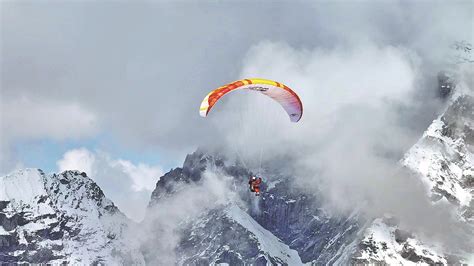
A Chinese paraglider experienced an unexpectedly perilous flight, ascending to an altitude of 28,000 feet (8,500 meters) after being caught in powerful updrafts, triggering a dramatic rescue operation. The incident occurred near Jilin City in northeastern China, placing the pilot, identified only as Mr. Zhang, in a life-threatening situation due to the extreme altitude and plummeting temperatures.
Mr. Zhang, an experienced paraglider, embarked on what was intended to be a routine flight. However, he encountered unexpectedly strong thermal updrafts that rapidly propelled him to an altitude far beyond what is typical or safe for paragliding. According to reports, the speed of the ascent was so rapid that he was unable to control his descent.
The incident prompted immediate concern from fellow paragliders and local authorities, who recognized the severity of the situation. At 28,000 feet, the atmospheric conditions are drastically different from those at sea level, with significantly reduced oxygen levels and temperatures that can drop to extreme lows. Exposure to such conditions can quickly lead to hypoxia (oxygen deprivation) and hypothermia, both of which pose serious and immediate threats to life.
After realizing the severity of his situation, Mr. Zhang managed to contact his friends on the ground using his radio. “I was suddenly swept up by a strong updraft,” he reportedly said in his distress call, according to local media outlets. “I’m going higher and higher, and it’s getting very cold.” This communication was crucial in alerting rescue services and providing them with real-time information about his location and condition.
The rescue operation involved multiple agencies, including local police, mountain rescue teams, and aviation authorities. Given the altitude and remote location, a helicopter was deemed necessary for a swift and effective rescue. The challenge was to reach Mr. Zhang quickly while also ensuring the safety of the rescue crew.
The helicopter crew located Mr. Zhang after an extensive search. He was found to be conscious but severely affected by the cold and lack of oxygen. A rescue specialist was lowered to Mr. Zhang, and he was then secured and hoisted into the helicopter. He was immediately flown to a nearby hospital for urgent medical treatment.
Upon arrival at the hospital, Mr. Zhang was assessed for hypothermia, hypoxia, and other altitude-related conditions. He was provided with supplemental oxygen and gradually warmed up to stabilize his body temperature. Doctors reported that he was fortunate to have survived the ordeal, given the extreme conditions he had endured.
The incident has raised questions about safety protocols for paragliding in areas known for strong thermal activity. Experts are calling for more stringent weather monitoring and better training for paragliders to handle unexpected updrafts and extreme altitude situations. There is also a renewed focus on the importance of carrying emergency equipment, such as oxygen tanks and thermal protection gear, when paragliding in potentially hazardous environments.
“This was a very close call,” said a spokesperson for the local aviation authority. “It highlights the risks involved in paragliding, especially in areas with unpredictable weather patterns. We need to ensure that all paragliders are fully aware of these risks and are adequately prepared to deal with emergencies.”
The paragliding community is also reflecting on the incident. Many are using it as a learning opportunity to review safety procedures and share best practices for dealing with similar situations. There is a consensus that while paragliding can be an exhilarating and rewarding activity, it is essential to approach it with caution and respect for the forces of nature.
Mr. Zhang’s unexpected high-altitude flight serves as a stark reminder of the potential dangers involved in extreme sports and the importance of preparation, communication, and swift rescue response in saving lives. The incident is expected to lead to a review of paragliding regulations and safety measures in the region, with the aim of preventing similar incidents in the future. The inquiry will consider factors such as weather forecasting accuracy, pilot training adequacy, and the effectiveness of emergency response protocols.
Furthermore, aviation experts suggest that the incident should prompt a broader discussion about the impact of climate change on weather patterns and the increased frequency of extreme weather events. They argue that unpredictable thermal updrafts and other weather anomalies are becoming more common, posing new challenges for paragliders and other outdoor enthusiasts.
The event also underscores the critical role of technology in ensuring the safety of paragliders. Advanced weather monitoring systems, GPS tracking devices, and reliable communication equipment are essential tools for mitigating risks and facilitating rapid rescue operations. There is a growing emphasis on integrating these technologies into paragliding gear and training programs.
In the aftermath of the incident, Mr. Zhang expressed his gratitude to the rescue teams and medical personnel who saved his life. He also acknowledged the importance of learning from the experience and sharing his insights with other paragliders. While shaken by the ordeal, he remains passionate about the sport and is committed to promoting safety and responsible flying practices.
The Chinese paragliding community is now focusing on enhancing safety education and promoting a culture of risk awareness. They are organizing workshops and training sessions to equip paragliders with the knowledge and skills needed to handle unexpected situations and make informed decisions in the air. These initiatives aim to foster a more responsible and safety-conscious approach to paragliding, ensuring that enthusiasts can enjoy the sport without compromising their well-being.
The incident involving Mr. Zhang is not an isolated case. Similar incidents have occurred in other parts of the world, highlighting the inherent risks associated with paragliding and the need for continuous improvement in safety standards. Aviation authorities and paragliding organizations are collaborating to share best practices and develop innovative solutions to mitigate these risks.
The story of Mr. Zhang’s high-altitude flight has captured the attention of people around the world, serving as a testament to the resilience of the human spirit and the importance of preparedness in the face of adversity. It also highlights the critical role of technology, communication, and coordinated rescue efforts in saving lives in extreme situations.
The incident has prompted a renewed focus on the ethical considerations surrounding paragliding and other adventure sports. There is a growing debate about the extent to which individuals should be allowed to engage in activities that carry inherent risks and the responsibility of authorities to protect them. Some argue that individuals have the right to pursue their passions, even if they involve risks, while others contend that society has a duty to ensure their safety.
The incident involving Mr. Zhang underscores the need for a balanced approach that respects individual autonomy while also prioritizing safety and well-being. This involves promoting responsible decision-making, providing comprehensive training, and implementing robust safety regulations. It also requires fostering a culture of risk awareness and encouraging individuals to prioritize their safety above all else.
Furthermore, the incident highlights the importance of ongoing research and development in the field of paragliding safety. This includes the development of new technologies, such as advanced weather forecasting systems and emergency communication devices, as well as the refinement of existing safety protocols and training programs. By investing in research and development, we can continue to improve the safety of paragliding and other adventure sports, ensuring that enthusiasts can enjoy these activities without undue risk.
The incident involving Mr. Zhang serves as a reminder that nature is a powerful and unpredictable force that must be respected. It also underscores the importance of humility and preparedness when engaging in outdoor activities, particularly those that involve inherent risks. By approaching nature with caution and respect, we can minimize the risks and maximize the rewards of exploring the natural world.
In conclusion, the story of Mr. Zhang’s accidental high-altitude flight is a cautionary tale that highlights the potential dangers of paragliding and the importance of safety, preparation, and swift rescue response. The incident has prompted a renewed focus on safety protocols, training programs, and technology integration in the paragliding community. It has also sparked a broader discussion about the ethical considerations surrounding adventure sports and the responsibility of individuals and authorities to ensure safety and well-being. By learning from this experience and implementing appropriate measures, we can continue to improve the safety of paragliding and other outdoor activities, allowing enthusiasts to enjoy these pursuits without compromising their lives.
The long-term impact of this incident remains to be seen. However, it is likely to lead to significant changes in the way paragliding is practiced and regulated in China and potentially in other parts of the world. These changes may include stricter licensing requirements, more comprehensive training programs, and enhanced safety regulations. They may also involve the development of new technologies and the implementation of more robust emergency response protocols.
Ultimately, the goal is to create a safer and more responsible paragliding community, one that is committed to minimizing risks and prioritizing the well-being of its members. This requires a collaborative effort involving paragliders, instructors, aviation authorities, and other stakeholders. By working together, we can ensure that paragliding remains a thrilling and rewarding activity without posing undue risks to those who participate.
The incident involving Mr. Zhang also underscores the importance of mental preparedness in extreme situations. The ability to remain calm and focused under pressure can be critical in surviving a life-threatening event. Paragliding training programs should include elements that focus on developing mental resilience and decision-making skills, preparing pilots to handle unexpected challenges in the air.
Moreover, the incident highlights the value of strong communication skills. Mr. Zhang’s ability to communicate his situation to his friends on the ground was instrumental in alerting rescue services and facilitating a swift response. Paragliding training should emphasize the importance of clear and effective communication, both with fellow pilots and with ground support teams.
The use of advanced technology, such as GPS tracking devices and emergency communication systems, can also play a crucial role in enhancing safety. These technologies can provide valuable information to rescue services, enabling them to locate and assist pilots in distress. Paragliding organizations should encourage the use of these technologies and provide training on their proper operation.
In addition to technology, proper equipment is essential for paragliding safety. This includes a well-maintained paraglider, a reliable harness, and appropriate protective gear, such as a helmet and thermal clothing. Paragliders should regularly inspect their equipment and ensure that it is in good working order. They should also be aware of the limitations of their equipment and avoid flying in conditions that exceed its capabilities.
The incident involving Mr. Zhang serves as a reminder that paragliding is not without risk. However, by taking appropriate precautions and following established safety guidelines, paragliders can significantly reduce the likelihood of accidents. This includes choosing suitable flying locations, monitoring weather conditions, and flying within their skill level.
Ultimately, the safety of paragliding depends on the individual pilot’s judgment and decision-making. Paragliders must be able to assess risks, make informed decisions, and react appropriately to changing conditions. This requires a combination of knowledge, skills, and experience.
Paragliding organizations play a vital role in promoting safety and providing education to their members. They offer training courses, organize flying events, and disseminate safety information. By joining a paragliding organization, pilots can access valuable resources and connect with other enthusiasts.
The incident involving Mr. Zhang has also raised questions about the role of government regulation in paragliding. Some argue that stricter regulations are needed to ensure safety, while others believe that excessive regulation can stifle innovation and limit access to the sport. A balance must be struck between ensuring safety and preserving the freedom of paragliders to enjoy their passion.
The incident involving Mr. Zhang has sparked a wide-ranging discussion about paragliding safety. This discussion is likely to continue for some time, and it will undoubtedly lead to changes in the way paragliding is practiced and regulated. The goal is to create a safer and more responsible paragliding community, one that is committed to minimizing risks and maximizing the rewards of this exhilarating sport.
Frequently Asked Questions (FAQ):
-
What caused the paraglider to ascend to such a high altitude?
The paraglider, identified as Mr. Zhang, was caught in unexpectedly strong thermal updrafts near Jilin City, China. These updrafts rapidly propelled him to an altitude of 28,000 feet (8,500 meters), far beyond a safe or typical altitude for paragliding.
-
What were the immediate dangers Mr. Zhang faced at that altitude?
At 28,000 feet, the atmospheric conditions are drastically different, posing significant risks. These include:
- Hypoxia: Significantly reduced oxygen levels, leading to oxygen deprivation.
- Hypothermia: Extremely low temperatures, potentially causing a rapid drop in body temperature.
- Frostbite: The extreme cold can cause tissue damage due to freezing.
- Altitude Sickness: Symptoms can include headache, nausea, and fatigue, impairing judgment and coordination.
-
How was Mr. Zhang rescued?
A coordinated rescue operation was launched involving local police, mountain rescue teams, and aviation authorities. A helicopter was used to locate Mr. Zhang. A rescue specialist was lowered to him, and he was secured and hoisted into the helicopter. He was then transported to a nearby hospital for medical treatment.
-
What measures are being considered to prevent similar incidents in the future?
Several measures are being considered, including:
- More stringent weather monitoring: Enhancing the accuracy and frequency of weather forecasts, particularly in areas prone to strong thermal activity.
- Improved pilot training: Providing paragliders with better training on how to handle unexpected updrafts and extreme altitude situations.
- Mandatory emergency equipment: Requiring paragliders to carry essential emergency equipment, such as oxygen tanks, thermal protection gear, and GPS tracking devices.
- Reviewing paragliding regulations: Re-evaluating and updating paragliding regulations to ensure they adequately address the risks involved in the sport.
-
What is the paragliding community doing in response to this incident?
The paragliding community is reflecting on the incident and using it as a learning opportunity to review safety procedures and share best practices. This includes:
- Organizing workshops and training sessions: Equipping paragliders with the knowledge and skills needed to handle unexpected situations and make informed decisions.
- Promoting a culture of risk awareness: Encouraging paragliders to prioritize safety and approach the sport with caution and respect for the forces of nature.
- Sharing best practices: Sharing knowledge and experiences to improve safety procedures and enhance preparedness for emergencies.









